Cruising Sri Lanka: What We Wish We’d Known Beforehand
The Ovens family set off from the east coast of Australia in 2020, cruising westward through South East Asia before crossing the Indian Ocean to Africa. One of their Indian Ocean stopovers was Sri Lanka and in this report mum Sarah provides some useful information that she wishes they had known before arriving in the country.
Published 6 months ago
A Great Time – But Some Prior Knowledge Would Have Helped
Although we really enjoyed our time in Sri Lanka there are a few things that cruisers need to consider and we wish we had been told. Firstly it is not a cruising ground, so, without permission from the powers that be, you are not allowed to freely anchor anywhere you please and there are no public moorings to speak of.
There are three possible ports to clear into (Trincomalee, Colombo and Galle) and that is where your vessel must stay for the duration of your visit. We chose Galle and can only speak of our experience there.
[Editor’s Note: After completing clearance at your port of entry, it is possible to sail to other ports provided you obtain a Sri Lanka Customs Outward Port Clearance from your departure port. There are additional costs involved. Access is only permitted to official ports of entry. Sri Lanka does not have any sheltered anchorages, so “cruising” here and anchoring is really not an option. See Sri Lanka Clearance for details.]
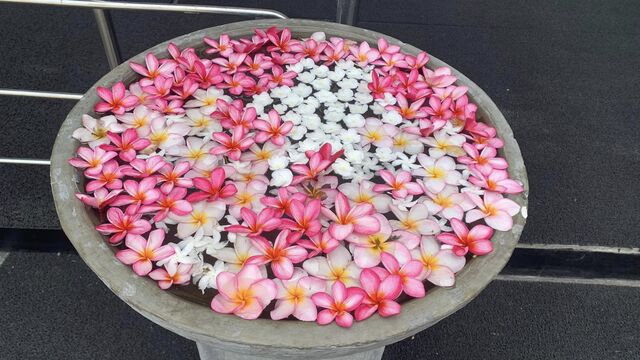

Port of Galle
Arrival:
You can only arrive into the Port of Galle during daylight hours and need to call the Harbour Master on VHF16 and obtain permission to enter. *There is the exception of a place to anchor just outside the harbour for night time arrivals here.
Port Security:
With round the clock security and guards at the entry gates, the Port of Galle is very secure. You will be given a security clearance document to get in and out of the gates.
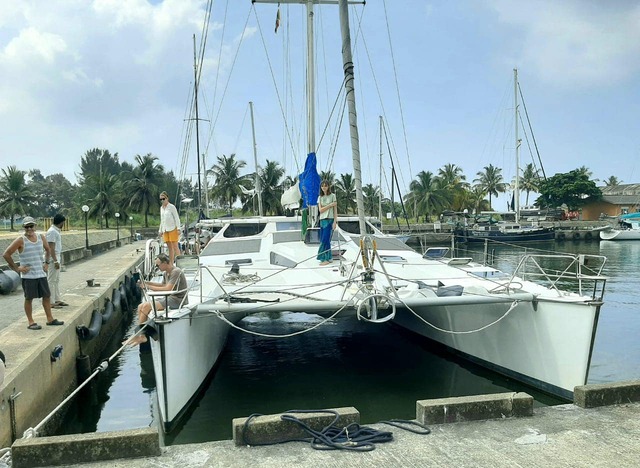

Docking in Galle:
Docking is side-tie to a concrete wall, but be warned there are exposed metal rings protruding from the walls and the black tyres will leave marks all over your gel coat if you don’t first use a board between your fenders. Our fender covers were ripped clean off and as they rolled along the tyres they transferred black marks all over our freshly polished starboard hull.
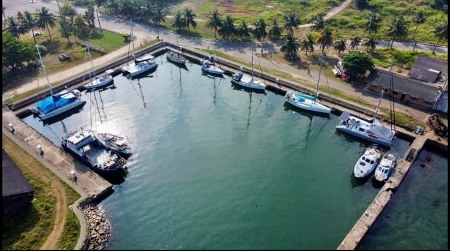

Depending on the weather, the harbour will get surge and there is a lot of movement, so you will need to find a way to prevent dock lines from chafing on the concrete walls. I would also consider ways to prevent rats climbing your lines.
Using an Agent:
It is best you have an agent arranged prior to departure and remain in contact with. We can highly recommend Achintha Isiwara who was there to meet us on a Sunday and even grabbed our lines then presented us with a welcome gift of baked goods and beers.
Having an agent is a requirement in Sri Lanka and trust me you will need one. Their services cost approximately $250 USD.
Bribes/Payments:
The line handlers who work for the Port will expect payment or alcohol for helping you tie your lines, but we did not oblige. The guards who patrol the grounds will also ask for cigarettes or alcohol. Personally we do not condone bribery, especially by officials. More and more is usually expected, thereafter making it difficult for the cruisers who follow.
Power:
Power is very expensive! Up to $450 USD/month. Also be very cautious! Surge protectors are a must!!! (We didn’t connect to power, but heard this from other cruisers.)
Water:
Water is fine for washing and laundry etc., but I would be cautious drinking the water unless you have filtration systems. You will need to ask your agent to arrange a meter to connect to water and it costs $12 USD / Tonne.
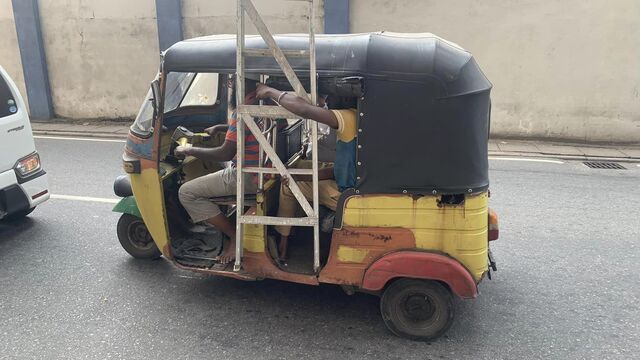

Parcels/Shipments:
If you are thinking of having anything shipped to Sri Lanka I would strongly recommend you avoid it at all costs. Customs will try to charge you double what the item is worth and refuse to release it to the courier company, effectively holding your item ransom unless you pay up.
*Side note: We arranged for a parcel (a new RO membrane) to be shipped to the Maldives without these import taxes and our agent, Asad, even arranged for it to be sent to a nearby Island where we were moored for a cost of $35USD, so we didn’t have to go into Male and collect it.
Roaming/stray dogs:
There are many stray dogs in Sri Lanka and quite a few within the Port grounds. While none actually bared teeth at any of us sailors, these dogs should definitely be avoided as Rabies is rampant in Sri Lanka. Disposing of rubbish properly is also advised and bins are located on site.
Concrete plant:
The concrete plant is no longer operational, so you needn’t worry about cement dust – which had been a big problem in the past.
Marine Services:
Beware of the men outside the gate offering Marine Services. They only act as a middleman and will charge you to tell you where to go for services. Your agent will be able to point you in the right direction and help you get what you need in and out of the gate.
Provisioning:
Provisioning can be very expensive in Sri Lanka, mainly because the Government are in deficit so all imported goods are taxed at 150%. You can get fresh seasonal fruit and vegetables from local grocers at reasonable prices but most western items such as cereal (box of cornflakes $8-$12 AUD), olive oil (1ltr $40 AUD), peanut butter (Small jar $15 AUD) are well above our budget.
*Note: these items are surprisingly much cheaper in the Maldives if you are headed that way. However, alcohol is cheaper and easier to get in Sri Lanka than the Maldives, so get supplies here if proceeding on. The local Lion Lager is quite a nice beer.
The Sri Lankan People:
The people in Sri Lanka are so lovely and welcoming! We had many friendly interactions and experiences we won’t forget.
Food:
If you like a curry/dhal you have come to the right place. Sri Lankan curries are beautiful. Other local delicacies we tried were Egg/Rice Hoppers, Kotthu, Biriyani, Roti and Paratha, Coconut pancakes.
Getting around:
There’s an App called Pickme – which – like Uber you can see the fare and get a fair deal.
Galle Fort:
We absolutely loved walking around the UNESCO Heritage sight of Galle Fort. There is so much to see. The architecture, history, ramparts, the coastline, lighthouse, swimming beach, canons you name it and dotted amongst it all are cafes, gelato stores, gift and gem shops, galleries and more.
You’ll see tricked out tuk-tuks and vintage morris minors, locals playing cricket, women dressed in stunning saris and maybe even a black faced langur or cow wandering around.
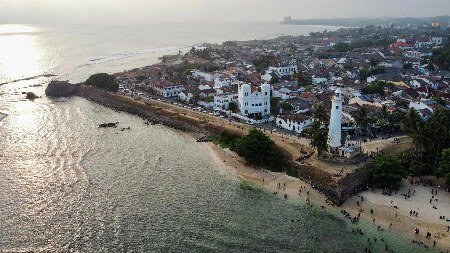

Beaches:
The beach of Bonavista is within walking distance from the Port and has good surf in the right season. There are lots of touristy beach bars/cafes and you can take surf lessons or hire boards. For the more experienced surfer, head to Marissa or Hikkaduwa.
Note: The main surf season is November-April for this coast. If you go to Hikkaduwa there is a beautiful Buddha monument honoring the victims of the Boxing Day tsunami and a small museum.
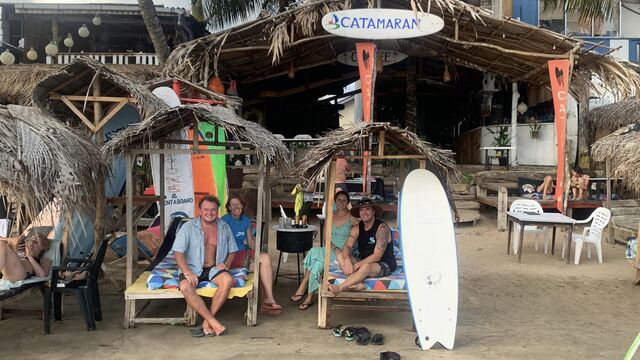

Other Activities in Sri Lanka:
If you have time up your sleeve, we recommend the following activities from what we did while in the country.
Kandy:
- Kandy Lake
- Kandy Lake Club Theatre – Traditional Dancing $3,500 LKR
- Temple of the tooth (Buddhist pilgrimage site (free entry but you pay for shoe service or lotus offerings)
Cricket Match:
(Pallekele International Cricket Stadium) $3,000-$4,000 LKR
Dambula cave temple:
$2,000 LKR
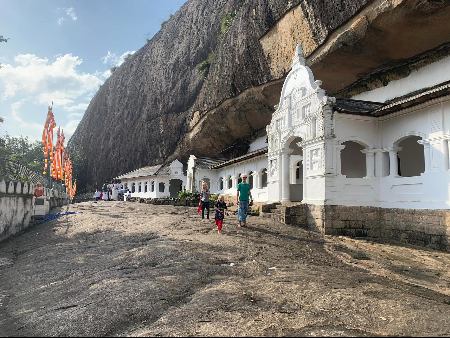

Train Rides:
Check out the famous Nine Arches Bridge (we recommend you get the train from Demodara to Nanu Oya) Odyssey Train will stop on the Nine Arches Bridge on Sunday ($6,000 LKR)
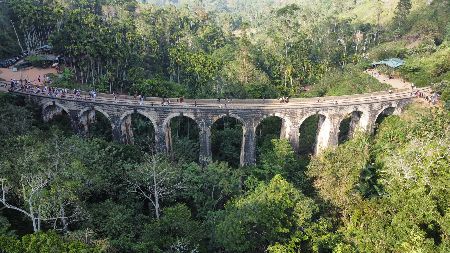

Tea Plantations:
- Nuwara Eliya – not far from Nanu Oya
- Labookellie do a FREE tour of their factory with no obligation to buy anything
Sigiriya:
- Sigiriya Rock is an amazing historical site and well worth a look, but tickets are $30USD. (Tour guide is extra).
- Sigiriya Village – there are many tree houses/nature lodges to stay at. We wish we spent another day here to do Pidurangala Rock. Elephants roam the fields here and there is a lot of bird life! We saw Peacocks/Hornbills/Green Bee Eater/Ceylon Hanging Parrot just from the balcony of where we were staying. Local food is exceptional and I recommend the vegetable and cheese kotthu.
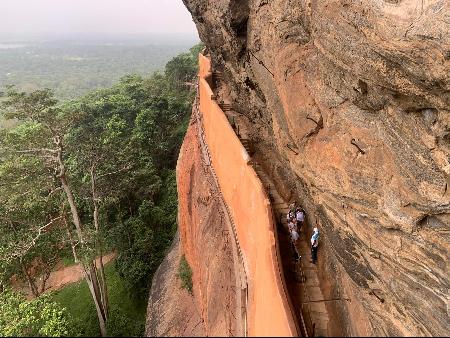

YALA National Park:
We wouldn’t recommend it to be honest. Some people love it, but we were left feeling very disappointed by this experience and if we had our time again, would have given it a miss.
It is very expensive and disorganized. No official receipt or ticket is given at the gate and our payment actually went to an Electrical Company. A guide costs extra and we spotted and knew more about the animals than our guide. You are asked to pay cash outside of the gate to drivers and they increased the price that we were quoted without explanation. Nothing suss!
The park is too crowded with many competitor Jeeps vying for position at sighting points. The roads are very rough dirt tracks so if you have a bad back you will not enjoy this ride. It ended up costing us around $400 AUD ($100 AUD per person – not the $30 USD advertised on Trip Advisor).
…………………………………
About the Authors:
The Ovens Crew are an Australian Live-aboard family who began cruising on their sailing catamaran, Excelsior, in 2020. Starting out on the east coast of Australia, they have since travelled extensively throughout Indonesia (for 12 months) and then onward to Thailand, Malaysia, Sri Lanka, Maldives and more recently they have crossed the Indian Ocean to explore the African Continent and its cruising grounds. Find out more about the Ovens family via their:
- You Tube Channel: https://www.youtube.com/@sailingexcelsior
- Instagram: instagram.com/theovenscrew
- Facebook: facebook.com/Sailing-Excelsior-108521981424036
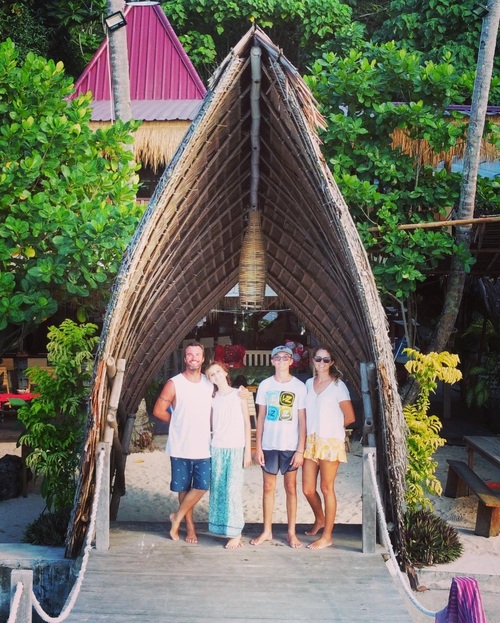

…………………………………
The opinions expressed in this article are the author’s own and do not reflect the view of Noonsite.com or World Cruising.
…………………………………
Find out all news, reports, links and comments posted on Noonsite, plus cruising information from around the world, by subscribing to our FREE monthly newsletter. Go to https://www.noonsite.com/newsletter/.
Related to following destinations: Colombo, Galle, Sri Lanka, Trincomalee
Related to the following Cruising Resources: Indian Ocean, Routing





